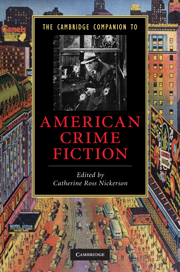Book contents
- Frontmatter
- 1 Introduction: The satisfactions of murder
- 2 Early American crime writing
- 3 Poe and the origins of detective fiction
- 4 Women writers before 1960
- 5 The hard-boiled novel
- 6 The American roman noir
- 7 Teenage detectives and teenage delinquents
- 8 American spy fiction
- 9 The police procedural in literature and on television
- 10 Mafia stories and the American gangster
- 11 True crime
- 12 Race and American crime fiction
- 13 Feminist crime fiction
- 14 Crime in postmodernist fiction
- Guide to reading
- Index
10 - Mafia stories and the American gangster
Published online by Cambridge University Press: 28 September 2010
- Frontmatter
- 1 Introduction: The satisfactions of murder
- 2 Early American crime writing
- 3 Poe and the origins of detective fiction
- 4 Women writers before 1960
- 5 The hard-boiled novel
- 6 The American roman noir
- 7 Teenage detectives and teenage delinquents
- 8 American spy fiction
- 9 The police procedural in literature and on television
- 10 Mafia stories and the American gangster
- 11 True crime
- 12 Race and American crime fiction
- 13 Feminist crime fiction
- 14 Crime in postmodernist fiction
- Guide to reading
- Index
Summary
Before the word “mafia” entered the American vocabulary, the bad guy portrayed in literature, dramas, radio programs, film and television was more often than not a bandit, a thief, a thug, or some other version of an outlaw who did bad deeds in dastardly ways that were more often than not discovered and punished by traditional social powers. The word “gangster” came to be used to represent the urban version of such a bad guy who worked with a band of criminals. The gangster as we know him today is a mix of fact and fiction. First appearing in the newspapers and newsreels of the 1920s, the gangster figure has grown to heroic proportions. Disseminated through powerful mass media exposure, the gangster subliminally serves as a cultural icon, reflecting changing notions of masculinity and socio-economic class in the United States.
The gangster, typically represented by a male figure, emerged in response to the evolution of corporate capitalism in the early twentieth century. Although criminal gangs had long occupied American cities, Prohibition and the desperate poverty brought on by the Great Depression in the 1930s provided opportunities for individual crime leaders to emerge and thrive. During the late 1920s and early 1930s, the exploits of gangsters such as Al Capone, John Dillinger, “Baby Face” Nelson and “Pretty Boy” Floyd became national news, fueled fictional accounts and captured the popular imagination. These real-life gangsters became more than ordinary criminals by committing their crimes with dashing and daring bravado; they were all blatant transgressors of the boundaries between good and evil, right and wrong, and rich and poor. As corporate capitalism promoted consumerism and widened the gap between rich and poor, Americans became infatuated with the gangster, whose stylish dress and fancy cars yet humble origins defied the boundaries separating social classes.
- Type
- Chapter
- Information
- The Cambridge Companion to American Crime Fiction , pp. 110 - 120Publisher: Cambridge University PressPrint publication year: 2010
- 3
- Cited by



